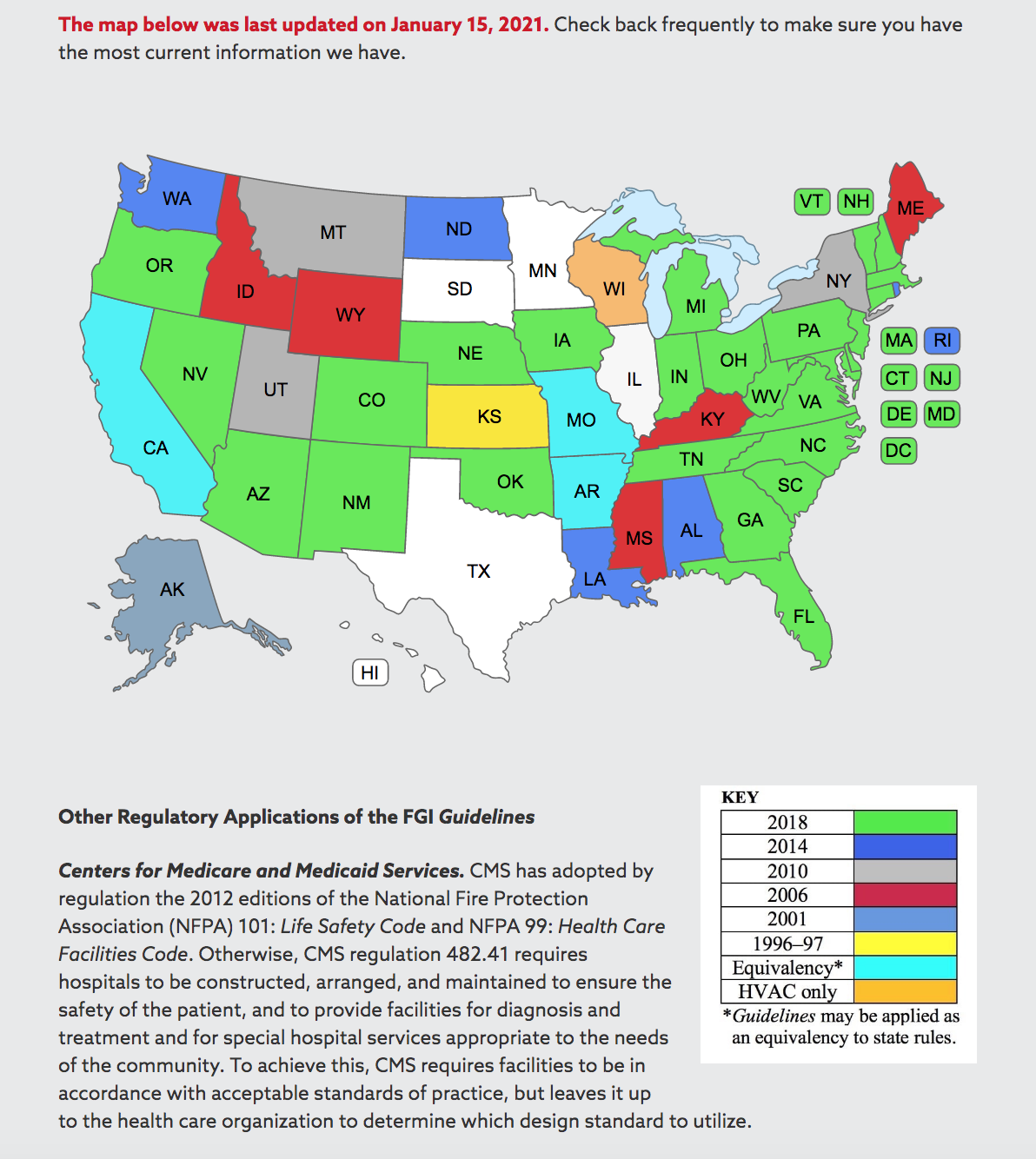Whether it's a hospital, outpatient facility, nursing home or residential care facilities there's a lot of complexity involved in bringing these spaces to life. If you have ever been involved in the planning, designing or construction of a healthcare facility, you know what this involves.
As a leading manufacturer in healthcare flooring, we wanted to sit down with the FGI and talk about the Guidelines, who puts them together, the revision process, how to access it, and how different states use it.
I sat down with, Doug Erickson, CEO of the Facility Guidelines Institute, and Yvonne Chiarelli, who's an associate editor for FGI. You can read the first part of our conversation, Why The FGI Guidelines Are Important. We'll dive into part 2 now.
It obviously takes a lot of talented people to put the guidelines together, so who does that?
YC:
We have a core group, but really the lifeblood of the guidelines are all of the volunteers and experts from around the country who get together to update them. It's not just a few people promulgating accolades and saying to do this or do that.
It's people who work hard because they care about patient safety, they care about the best information and about being able to bring their experience along with current trends. It's a multidisciplinary body of clinicians, physicians, architects, engineers and regulators. There's a lot of participation by various authorities having jurisdiction from different states. They're all able to collaborate and keep the revision process alive. The guidelines are all about these people bringing their experience and talent to the table to benefit patient safety.
DE:
We have approximately 130 people on the Health Guidelines Revision Committee. It's multidisciplinary; we try and cover all our bases as far as the special matter experts that we're bringing in, whether they're security professionals, professionals in infection prevention, etc. This is the same kind of team you would see in a major project at a healthcare facility, so everybody has a say in new or revised requirements.
When we are putting together the guidelines and they're reviewed and issued every four years, we probably have close to 500 people who get involved in one way, shape or form. Whether it's through the formal committee itself, special matter experts, or people we rely on to give us information through proposals or comments. It's a very robust process to go from issuing one edition to the revision and issue of a second edition.
Read Part 1: Why The FGI Guidelines Are Important
KG:
You mentioned the revision process. Is that every four years?
YC:
Well, that's a fun-filled four years where we convene a committee, a group of more than 100 people. There are three major parts. We start with the proposal period. We invite the public, and we convene the committee. We invite everyone to submit proposals through technology to update.
Doug is a great proponent of saying, "Hey folks, what do you want to change in the guidelines? This is your opportunity to update, make it better, revise things, insert trends." The proposal period is a time when we get the new information, and the committee starts looking at the proposals and making decisions about what the revisions they'd like to see.
At the end of the proposal period we come up with a draft of the new forthcoming edition. Then we put it out again for public comment so the world can see what's happening and comment. They get to actually see the whole draft of the document.
They see where the changes are, what's coming, what's going, what's being added. Then they again get to make comments about these revisions, and we again collect all of that information. The public has quite a say in what's going to be in the document. Wherever it's not black and white, the committees then reconvene, and they talk about it. Then they make a new round of decisions to come up with the final document.
That takes us through about two years of effort, so you can think about it as we've got the proposal period, we come up with a draft, we've got a comment period. Then we come up with the final manuscript. Through that whole process has been tug and pull and discussion and opinions, and maybe some spirited conversation.
Then we finally get to the point where all the decisions have made about what's going into the document. We actually get into the editorial portion of the phases in the third year and putting this together and making sure all the I's are dotted and T's are crossed.
Then, because we're a publisher, we've taken over that piece. So for 2022 that's going to be the edition released to the public by that date. Maybe you can talk more about this last phase Doug, where it gets vetted. Those are the main parts of the four-year process before it starts over again.
DE:
First, we really need the public's input on the document as we go through the revision process. This means pushing owners to tell us if this is working for you or if there is a lot of wasted space. Or have we missed some spaces that are new because of some new technology or new medical programs.
We push the architectural community to say if we are clear enough in our language for you to take the expectations of the owner and make the design documents and the construction documents as they need to be. Then we push the authorities having jurisdiction to make sure the language in the guidelines is enforceable or is clear enough that it lacks the need for an interpretation.
BioSpec Armor - Breezy OR122 and Hush OR111
KG:
When all this is published, and the edition is out, can people access it either as a physical book or digitally, and how do they get it?
YC:
We are working with a vendor who acts as our e-commerce partner, MADCAD.com. The guidelines are available in a soft cover printed book, hardcover book, and we also make it available online. You just need an internet connection, and you can get a subscription for digital access. It's wherever you are with an internet connection, so it's accessible.
KG:
Does every state adopt the guidelines uniformly?
DE:
We wish the federal agency called the Center for Medicare and Medicaid Services would adopt our guidelines. We've been pushing for that for the last 30 years. We are what I consider a code or a standard, but we continue to hold on to the term guidelines simply because we don't have any power of public law or federal law.
It takes a federal agency or a state agency, or even a private organization like The Joint Commission to adopt and write us into law through legislation. Or adopt us automatically because the prior legislation says anytime the guidelines are updated, the new guidelines become state law.
We write our standard very similar to the National Fire Protection Association, to ASHRAE, to the International Code Council. It should not be anything that is unique to the eyes and ears of a design professional or a specifier, because of the way that we model ourselves against these other national organizations.
KG:
If each state can adopt legislation at its own pace, how do you find out the guidelines' status where you live and/or work?
YC:
We have a couple of ways. We keep an adoption map on our website, where we keep up with various contacts in different states. We update it continually as states adopt or change. We depend on those contacts to keep us informed. One can also contact their local department of health to find out what they're doing, what they've adopted.
DE:
When you click on the map, you can scroll your cursor over the state you're interested in and you’ll see a pop-up box to tell you exactly how the guidelines are being applied in that state. It'll tell you if they adopted the hospital document or outpatient or residential? And, by the way, they have adopted residential, but it's only for nursing home, or it's only for assisted living.
It'll tell you the addition they've currently adopted. Or as in the case of New York state, it'll tell you that although they're on the 2010, they will permit you to use the ’14 or the ’18 document if you want to design to that in its entirety. About 75-80% of the design within the state of New York is to the 2018 document, although formally when you look at the map, they're still on the 2010.
It's really imperative that a specifier or even somebody who is looking at supplying material to a new construction or a major renovation, click on that map and get a good sense of what that state is and is not enforcing as far as the guidelines.
DE:
Kathy all they have to do is go on the homepage to the upper right-hand corner, and it says adoption map. Click on Adoption Map snf if they want to learn more about the guidelines, we have probably six or seven pages of history on the website. They can go onto the website and just click on the history, and it'll give them a really great story about who we are, where we came from and who we hope to be in the future.
KG:
What are some other things beyond the adoption map that we can find on your website?
YC:
We keep people updated on where we are in the revision process. We also offer the Beyond Fundamentals library, a collection of white papers and contributions by various authors that supplement the guidelines. While the guidelines are the fundamental requirements, the minimum requirements, these papers provide information that are beyond that, such as case studies. There's actually a study about flooring on there. There is a patient handling assessment tool, a mobility assessment tool, and they're all free.
KG:
Doug, anything else you want to add before we wrap up?
DE:
Sure. To expound on what Yvonne said, you can also sign up for updates and get a quarterly bulletin we send out. The quarterly bulletin looks at either formal interpretations, or a new section we're working on, or some new information on something like telemedicine and standards. It's very content driven. We probably have close to 7,000, 8,000 subscribers right now but we don't and will never sell that list or provide it to other organizations or manufacturers. We are very conscious that people are inundated with emails. If you see more than two coming from us a month, that would be a lot.
KG:
Sounds like there's a lot of great information on your website. The guidelines contain evidence-based design knowledge and it's vital for every specifier, end-user, and manufacturers to learn and know about. I appreciate you joining us Doug and Yvonne, and I really think that this was helpful in learning about what FGI is and how it can best be used. Thanks for your time.
FGI is a vital resource for healthcare architects, designers and specifiers – and the vendors who serve them. By becoming familiar with the Guidelines and the version used in each state, the process of designing and creating functional, efficient and successful facilities that work for both healthcare providers and patients. For more information, contact your Mannington Commercial healthcare sales rep and visit fgiguidelines.org.

.jpg?width=1080&name=BioSpecArmor_Breezy_OR122_Hush_OR111_RoomScene%20(2).jpg)
